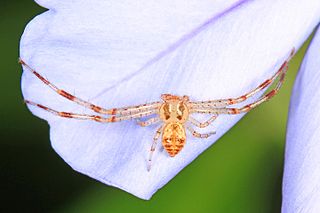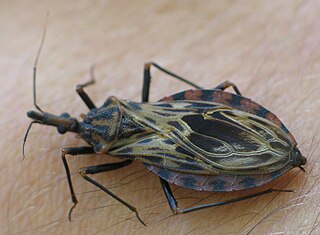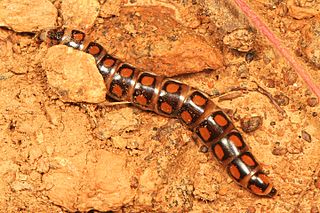
The Thomisidae are a family of spiders, including about 170 genera and over 2,100 species. The common name crab spider is often linked to species in this family, but is also applied loosely to many other families of spiders. Many members of this family are also known as flower spiders or flower crab spiders.

The Year 2038 problem is a time formatting bug in computer systems with representing times after 03:14:07 UTC on 19 January 2038.

Jet Set Willy is a platform video game originally written by Matthew Smith for the ZX Spectrum home computer. It was published in 1984 by Software Projects and ported to most home computers of the time.

Misumena is a genus of crab spiders sometimes referred to as flower crab spiders. They are similar in appearance to several other genera in the family Thomisidae, such as Misumenoides and Mecaphesa.

Triatoma is a genus of assassin bug in the subfamily Triatominae. The members of Triatoma are blood-sucking insects that can transmit serious diseases, such as Chagas disease. Their saliva may also trigger allergic reactions in sensitive individuals, up to and including severe anaphylactic shock.

Misumenops is a common genus of crab spider with more than 50 described species.

Triatoma dimidiata is a blood-sucking insect whose range extends from northern South America, throughout all the countries of Central America and into Southern Mexico. It is among the most important carriers of Trypanosoma cruzi, the flagellate protozoa that causes Chagas disease. Dimidiata has been found in rock piles, caves occupied by bats, hollow trees occupied by mammals or birds, and other diverse ecotopes. However, their presence in human abodes is usually happenstance; people tend to bring them indoors with their firewood. When in the nymph form they may camouflage themselves from predators by scraping dust over their dorsal abdomen, a behavior also observed in T. phyllosoma, T. nigromaculata, Panstrongylus geniculatus, P. megistus and P. herreri nymphs. Moreover, due to geological past in Mesoamerica such as forest loss, and rising temperatures, there has been an increase in Triatomine bugs infestation.

Triatoma nigromaculata is a sylvatic species of insect usually found in hollow trees, in vertebrate nests on trees and occasionally in human dwellings. It usually lives in relatively humid forests at high altitudes on mountain regions and foot hills. As all members of the subfamily Triatominae, T. nigromaculata is a blood-sucking bug and a potential vector of Chagas disease. This species is distributed mainly in Venezuela, but some specimens have also been found in Perú and Colombia (Cauca).

Misumena vatia is a species of crab spider with a holarctic distribution. In North America, it is called the goldenrod crab spider or flower (crab) spider, as it is commonly found hunting in goldenrod sprays and milkweed plants. They are called crab spiders because of their unique ability to walk sideways as well as forwards and backwards. Both males and females of this species progress through several molts before reaching their adult sizes, though females must molt more to reach their larger size. Females can grow up to 10 mm (0.39 in) while males are quite small, reaching 5 mm (0.20 in) at most. Misumena vatia are usually yellow or white or a pattern of these two colors. They may also present with pale green or pink instead of yellow, again, in a pattern with white. They have the ability to change between these colors based on their surroundings through the molting process. They have a complex visual system, with eight eyes, that they rely on for prey capture and for their color-changing abilities. Sometimes, if Misumena vatia consumes colored prey, the spider itself will take on that color.

A Hare Grows In Manhattan is a Warner Bros. cartoon in the Merrie Melodies series, released on March 22, 1947. It was produced by Edward Selzer and directed by I. Freleng. The short features Bugs Bunny.
Cardioglossa nigromaculata is a species of frog in the family Arthroleptidae. It is found in the south-western Cameroon and in the extreme southern Nigeria at low altitudes. Common name blackspotted long-fingered frog has been coined for it.
Pseudoeurycea nigromaculata, commonly known as the black-spotted salamander or black-spotted false brook salamander is a species of salamander in the family Plethodontidae. It is endemic to Veracruz, Mexico, and known from Cerro Chicahuaxtla ) in Cuatlalpan and from Volcán San Martín at elevations of 1,200–1,300 m (3,900–4,300 ft). These separate populations likely represent distinct species.

The black-spotted bare-eye is a species of insectivore passerine bird in the antbird family Thamnophilidae. It is found in Bolivia, Brazil, Colombia, Ecuador, and Peru. Its natural habitats are subtropical or tropical moist lowland forests.
Misumena oblonga is a spider species found in Yarkant County of western China. A close relative, also from the Misumena genus, is Misumena vatia.

Willowsia nigromaculata is a member of the family Entomobryidae. It has a metallic iridescent body and is covered in translucent scales. It is often found indoors in places such as houses, garages and greenhouses.

Nezara is a genus of plant-feeding stink bug of the family Pentatomidae.

Willowsia is a genus of slender springtails in the family Entomobryidae. There are about six described species in Willowsia.

Phengodes nigromaculata is a species of glowworm beetle in the family Phengodidae. It is found in North America.

Mecaphesa asperata, the northern crab spider, is a species of crab spider in the family Thomisidae, found in North and Central America, and the Caribbean. It is a species of the 'flower spiders', so-called because they generally hunt in similarly coloured flowers for visitors such as bees and flies, and is a much smaller nearctic relative of the better-known Goldenrod Spider.

Lycaena xanthoides, the great copper, is a species of copper in the butterfly family Lycaenidae. It is found in North America.

















